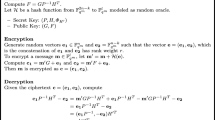Abstract
Recently, Kim et al. proposed a modified Dual-Ouroboros public-key encryption (\({\textsf{PKE}}\)) using Gabidulin codes to overcome the limitation of having decryption failure in the original Dual-Ouroboros using low rank parity check codes. This modified Dual-Ouroboros \({\textsf{PKE}}\) using Gabidulin codes is proved to be IND–CPA secure, with very compact public key size of 738 bytes achieving 128-bit security level. However, they did not specify on their choice of the secret key S used in their \({\textsf{PKE}}\). In this paper, we analyze different possible choices for S in the modified Dual-Ouroboros \({\textsf{PKE}}\) using Gabidulin codes. More specifically, we show that if S is invertible over \({\mathbb{F}}_{q^m}\) without any restriction, then the decryption algorithm will fail. Furthermore, we show that Kim et al.’s proposal of the modified Dual-Ouroboros \({\textsf{PKE}}\) using Gabidulin codes has secret key S over \({\mathbb{F}}_q\) for its decryption algorithm to be correct. Then, we proposed two attacks: key recovery attack and plaintext recovery attack on their \({\textsf{PKE}}\) with S over \({\mathbb{F}}_q\). We are able to recover the secret key for all the proposed parameters within 235 seconds. Moreover, we show that the public key matrix in their proposal generates a subcode of Gabidulin code. As a consequence, we can apply the Frobenius weak attack on their proposal and recover the plaintext for all the proposed paramters within 0.614 second. Finally, we give a proposal for the modified Dual-Ouroboros \({\textsf{PKE}}\) using Gabidulin codes such that it is correct and secure, by considering certain restrictions on S over \({\mathbb{F}}_{q^m}\).
Similar content being viewed by others
References
Aguilar-Melchor, C., Aragon, A., Bettaieb, S., Bidoux, L., Blazy, O., Deneuville, J.C., Gaborit, P., Hauteville, A., Zémor, G.: Ouroboros-R. http://pqc-ouroborosr.org (2017). Accessed 8 Dec 2019
Aragon, N., Gaborit, P., Hauteville, A., Tillich, J.-P.: A new algorithm for solving the rank syndrome decoding problem. In: Proceedings of IEEE International Symposium on Information Theory (ISIT 2018), pp. 2421–2425 (2018)
Berlekamp, E., McEliece, R., Tilborg, H.V.: On the inherent intractability of certain coding problems. IEEE Trans. Inf. Theory 24(3), 384–386 (1978)
Bardet, M., Briaud, P., Brox, M., Gaborit, P., Neiger, V., Ruatta, O., Tillich, J.-P.: An Algebraic Attack on Rank Metric Code-based Cryptosystems. CoRR abs/1910.00810 (2019)
Gabidulin, E.M.: Theory of codes with maximum rank distance. Probl. Peredachi Inf. 21(1), 3–16 (1985)
Gaborit, P.: Attack on McNie—Post-Quantum Cryptography, Round 1 Submisions, McNie, Official Comments. https://csrc.nist.gov/CSRC/media/ Projects/Post-Quantum-Cryptography/documents/round-1/official-comments/ McNie-official-comment.pdf (2017). Accessed 8 Dec 2019
Gaborit, P., Galvez, L., Hauteville, A., Kim, J.-L., Kim, M.J., Kim, Y.-S.: Dual-Ouroboros: an improvement of the McNie scheme. Adv. Math. Commun. (2019). https://doi.org/10.3934/amc.2020021
Gaborit, P., Ruatta, O., Schrek, J.: On the complexity of the rank syndrome decoding problem. IEEE Trans. Inf. Theory 62(2), 1006–1019 (2016)
Gaborit, P., Ruatta, O., Schrek, J., Zémor, G.: New results for rank-based cryptography. In: Proceedings of Progress in Cryptology (AFRICACRYPT 2014), pp. 1–12 (2014)
Galvez, L., Kim, J., Kim, M.J., Kim, Y., Lee, N.: McNie: Compact McEliece–Niederreiter Cryptosystem—A Public-key Encryption proposal for the NIST’s call. https://csrc.nist.gov/CSRC/media/Projects/Post-Quantum-Cryptography/documents/round-1/submissions/McNie.zip (2017). Accessed 8 Dec 2019
Gaborit, P., Zémor, G.: On the hardness of the decoding and the minimum distance problems for rank codes. IEEE Trans. Inf. Theory 62(12), 7245–7252 (2016)
Horlemann-Trautmann, A., Marshall, K., Rosenthal, J.: Considerations for rank-based cryptosystems. In: Proceedings of IEEE International Symposium on Information (ISIT 2016), pp. 2544–2548 (2016)
Horlemann-Trautmann, A., Marshall, K., Rosenthal, J.: Extension of overbeck’s attack for Gabidulin based cryptosystems. Des. Codes Cryptogr. 86(2), 319–340 (2018)
Kim, J.-L., Kim, Y.-S., Galvez, L.E., Kim, M.J.: A modified Dual-Ouroboros public-key encryption using Gabidulin codes. Appl. Algebra Eng. Commun. Comput. (2019). https://doi.org/10.1007/s00200-019-00406-x
Marshall, K.: A study of cryptographic systems based on Rank metric codes. Ph.D. Dissertation, University of Zurich (2016)
Loidreau, P.: A Welch–Berlekamp like algorithm for decoding Gabidulin codes. In: Proceedings of the International Workshop on Coding and Cryptography (WCC 2005), pp. 36–45 (2005)
Loidreau, P.: A new rank metric codes based encryption scheme. In: Proceedings of the 8th International Conference on Post-Quantum Cryptography (PQCrypto 2017), pp. 3–17 (2017)
Lau, T.S.C., Tan, C.H.: Key recovery attack on McNie based on low rank parity check codes and its reparation. In: Proceedings of Advances in Information and Computer Security (IWSEC 2018), pp. 19–34 (2018)
Lau, T.S.C., Tan, C.H.: New rank codes based encryption scheme using partial circulant matrices. Des. Codes Cryptogr. 87(12), 2979–2999 (2019)
Overbeck, R.: Structural attacks for public key cryptosystems based on Gabidulin codes. J. Cryptol. 21(2), 280–301 (2008)
Acknowledgements
We are grateful to the anonymous reviewers for their careful reading of our manuscript and their many insightful comments and suggestions which have greatly improved this manuscript.
Author information
Authors and Affiliations
Corresponding author
Additional information
Publisher's Note
Springer Nature remains neutral with regard to jurisdictional claims in published maps and institutional affiliations.
Rights and permissions
About this article
Cite this article
Lau, T.S.C., Tan, C.H. & Prabowo, T.F. On the security of the modified Dual-ouroboros PKE using Gabidulin codes. AAECC 32, 681–699 (2021). https://doi.org/10.1007/s00200-020-00419-x
Received:
Revised:
Accepted:
Published:
Issue Date:
DOI: https://doi.org/10.1007/s00200-020-00419-x
Keywords
- Code-based cryptography
- Key recovery attack
- Plaintext recovery attack
- Gabidulin code
- Public-key encryption




